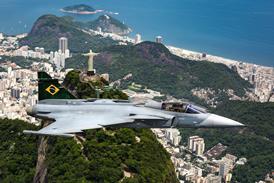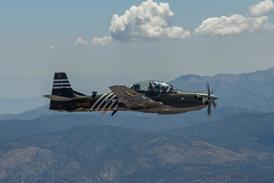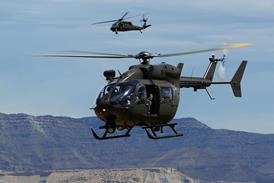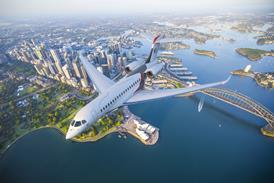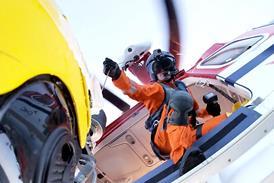Our quarterly poll finds confidence, orderbooks and job prospects rising again for Top 100 manufacturers
The soaring cost of fuel is failing to dampen the mood of the world’s leading aerospace companies, despite the headaches it is causing for airlines. Although oil prices are cancelling out benefits major carriers might have expected as a result of rising traffic and new markets (Flight International, Top 50 Airlines 18-24 October), optimism, orderbooks and job prospects in the manufacturing sector remain buoyant.

The Flight International/PricewaterhouseCoopers quarterly Aerospace Trends Survey finds that the gap is continuing to grow between those who feel postive about their business performance and those who feel negative.
A glance at the graph at the top of this page shows how much and how quickly the industry’s performance and prospects have improved in the almost three years since we started the survey, with the balance of positive responses at its highest yet on all three questions.
Twenty-four of our sample of 40 Top 100 aerospace companies, polled in early October, say they feel more confident about the outlook for their business now than when they previously answered the same question three months earlier.
With no respondents feeling less confident, and 16 saying they feel the same, this gives a balance of 24 or 60%. This is slightly up from the last survey, which was carried out at the end of the second quarter, and is the highest total since we began the Trends Survey at the start of 2003.
Despite worries in the long-term about military budgets and programme cuts, and in the short-term about airline profitability and viability, current bulging orderbooks appear to be fuelling the feelgood factor among manufacturers. A total of 26 of our respondents say the third quarter was better in terms of orders than the same quarter of 2004. Again, no companies say orderbooks have fallen from a year ago, and, with 14 neutrals, the balance is 65%. This is again the highest figure since the survey began and the third quarter in a row this figure has risen. Apart from a small blip in the first quarter of this year, the trend has been upward since the end of 2003. This is reflected in rapidly growing backlogs from the two major airliner manufacturers, which are in turn providing a ripple effect down the supply chain.
According to Neil Hampson of PricewaterhouseCoopers, whose team compiles the survey, one of the biggest challenges now facing manufacturers, from airframers to companies further down the supply chain, is how they meet rising customer demand. The speed of the recovery has caught many in the industry on the hop, and many manufacturers are struggling to buy in components and raw materials quickly enough, and find the skilled staff they need to meet schedules. “The issue for many is how they actually deliver,” he says.
This is reflected in the response to the question about employment prospects. Until mid-2004, most experts believed that improving order books and confidence would not be matched by growing headcount. After the 9/11 downturn most manufacturers were forced to focus on their bottom line, shedding surplus jobs and working hard at improving production efficiencies. The thinking was that these leaner, meaner, fitter companies would be able to ramp up production as business improved without having to recruit corresponding numbers of staff – the classic jobless recovery.
However, with exactly half our 40 respondents expecting to increase their workforce over the next 12 months, compared with only two who plan to retrench, the balance of 45% is 10 percentage points up on the previous survey and, yet again, the highest total since the trends survey began.
According to Hampson, manufacturers across all regions and sectors are looking to recruit. “Employment is always a lagging indicator, and taking on new staff demonstrates that companies are confident orders will continue to come in,” he says.
Manufacturers are also shrugging off rising raw material costs, says Hampson, with most confident they can pass them on to customers. However, the strong euro continues to negatively affect companies outside the dollar zone, with 10 of the 18 European companies polled positive on confidence, compared with 13 of the 17 North Americans.
Hampson says the weak dollar – still at around 1.2 to the euro, compared to a recent high of around 1.25 – is not yet a major concern, but might begin to have an impact on European industry’s confidence if it begins to erode profits, despite buoyant order books.
On the other two questions, there is little difference between the regions. On orders, the Europeans have the edge, slightly, with 13 out of 18 more confident, and 10 of the 17 Americans feeling the same way. On jobs, North Americans are more positive, with 10 of them and nine of the Europeans looking to increase headcount.
- The Flight International/PricewaterhouseCoopers Aerospace Trends Survey questions the same 40 companies each quarter. All ranked among the industry’s biggest 100 businesses by turnover, they represent both prime contractors or airframers and component and system suppliers. Eighteen are from Europe, 17 from North America and five from the rest of the world. Figures are reached by subtracting negative responses from positive responses and expressing the number as a percentage.
HELEN MASSY-BERESFORD
Source: Flight International




